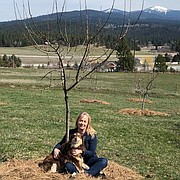OPAL’S HOMESTEAD HACKS Planting — with cardboard, of course
If you’ve been following Opal Harbert’s brand of “lazy” homestead tips, you may already be saving those carrot peels and lettuce ends as garden compost. Now that the sun is out again, I asked Opal for more outdoor ideas.
Naturally, they’re all about recycling. Why throw away when you can repurpose?
“Anytime you have something in your hands or in front of you, say ‘What can I use this for?’”
Let’s start with water, that elixir of life. Spring rains and melting snow can nourish more than the ground, especially if you have critters. Opal catches the water from her gutters.
“Chickens can drink out of it, but it works for dogs too,” she said. “I have a big water trough under my barn because so much rain comes off of that. Or it’s nice just to have a reserve of water.”
When she was a kid, Opal’s family lived simply in the boonies, building, making, and doing their own — well, everything. That’s how Opal got this way.
And why cardboard is buried in her garden.
“Putting cardboard down and mulching over it (before adding plants) works as a weed barrier, and keeps moisture in. It’s free and breaks down anyway.”
Sometimes called sheet or lasagna mulching, just make sure it’s plain, with no tape, plastics or heavy dyes. While not everyone is a fan, it’s listed in University of Idaho Extension’s online mulching guide at Bit.ly/2JOh7Ck.
“Pine needles are great to stop weeds too,” Opal said, cautioning that not every plant likes pine needles. “I use them mostly for my berries and along the garden path. And for my fruit trees.”
Another thing good for berries, hydrangeas and other acid-loving plants is coffee grounds and tea leaves.
Not to mention the dregs of winter.
“Oh, and the bark from my firewood goes along the path in my berry patch. Great to keep weeds down and breaks down into beautiful soil!
“Ash from fireplaces or bonfires is good for acidic soil; it will make it more alkaline,” she added. “I already have alkaline soil, so I just dump it into my compost pile.”
And she begs us not to be too hasty disposing of debris as we garden.
“When I clean up my flower beds, I just put last year’s dead matter under the plant. It creates a habitat for beneficial bugs, breaks down into nutrients for the soil, and feeds the worms.”
“Plus the bugs that live in it provide good protein for birds to feed their babies.”
Speaking of birds, an addendum from last week: Leaving long and fine human hair for bird nests, cautions one Press reader, may choke them. Best stick to animal hair. Thanks, Anne.



